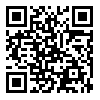year 3, Issue 12 (11-2004)
J. Med. Plants 2004, 3(12): 1-8 |
Back to browse issues page
Download citation:
BibTeX | RIS | EndNote | Medlars | ProCite | Reference Manager | RefWorks
Send citation to:



BibTeX | RIS | EndNote | Medlars | ProCite | Reference Manager | RefWorks
Send citation to:
Taghizadeh M, Yasa N, Naqinezhad A, Ahvazi M. Review of Centella asiatica (L.) Urban.. J. Med. Plants 2004; 3 (12) :1-8
URL: http://jmp.ir/article-1-721-en.html
URL: http://jmp.ir/article-1-721-en.html
1- Institute of medicinal plants, Iranian Academic Center for Eduction, Culture and Research, Tehran, Iran , Mitra_Taghizadeh@yahoo.com
2- Department of Pharmacognosy, Faculty of Pharmacy, University of Medical Sciences, Tehran, Iran
3- Department of Botany, Faculty of Science, Tehran University, Tehran, Iran
4- Institute of medicinal plants, Iranian Academic Center for Eduction, Culture and Research. Scince and research Unit, Islamic Azad University, Tehran, Iran
2- Department of Pharmacognosy, Faculty of Pharmacy, University of Medical Sciences, Tehran, Iran
3- Department of Botany, Faculty of Science, Tehran University, Tehran, Iran
4- Institute of medicinal plants, Iranian Academic Center for Eduction, Culture and Research. Scince and research Unit, Islamic Azad University, Tehran, Iran
Abstract: (11373 Views)
AB-Boshghabi (Centella asiatica) from Apiaceae family, has been used as a traditional herbal medicine in Asiatic countries for hundreds of years. This plant is indigenous to the warmer regions of both hemispheres, including southeast Africa, Asia, Srilanka, the Pacific Islands, Madagascar, Eastern South America, Venezuela, Columbia. It is especially abundant in the swampy areas of India, Iran (around the Anzali lagoon), and Pakistan, Upto an altitude of approximately 700m. This hygrophyte plant is considered as a “vulnerable species” in the Red data book of plant species of Iran. This valuable hygrophyte species has a definitely exclusive habitat around the Anzali lagoon. The major principles are the triterpenes asiatic acid and madecassic acid, and their derived triterpene ester glycosides, asiaticoside and madecassoside. The major clinical indications for the use of centella asiatica in human include the treatment of wounds, venous insufficiency of the limbs, Certain mycobacterial infections and cellulitus. In the present article, we review mainly medicinal aspect of Centella asiatica that hitherto has not received much attention.
Type of Study: Review |
Subject:
Medicinal Plants
Received: 2003/03/4 | Accepted: 2004/11/7 | Published: 2004/12/15
Received: 2003/03/4 | Accepted: 2004/11/7 | Published: 2004/12/15
Send email to the article author
| Rights and permissions | |
 |
This work is licensed under a Creative Commons Attribution-NonCommercial 4.0 International License. |








